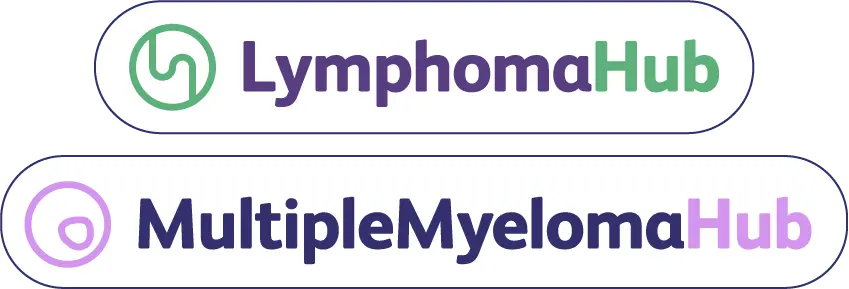All content on this site is intended for healthcare professionals only. By acknowledging this message and accessing the information on this website you are confirming that you are a Healthcare Professional. If you are a patient or carer, please visit the Lymphoma Coalition.
The Lymphoma Hub uses cookies on this website. They help us give you the best online experience. By continuing to use our website without changing your cookie settings, you agree to our use of cookies in accordance with our updated Cookie Policy
An expert panel hosted by

Sequencing immune-based therapies in B-cell malignancies
with Ulric Jäger, Sagar Lonial, and Krina Patel

Saturday, June 15 | 18:00-19:30 CEST
Register nowThis independent education activity is sponsored by Bristol Myers Squibb. All content is developed independently by the faculty. Funders are allowed no direct influence on the content of this activity.
The Lymphoma Hub website uses a third-party service provided by Google that dynamically translates web content. Translations are machine generated, so may not be an exact or complete translation, and the Lymphoma Hub cannot guarantee the accuracy of translated content. The Lymphoma Hub and its employees will not be liable for any direct, indirect, or consequential damages (even if foreseeable) resulting from use of the Google Translate feature. For further support with Google Translate, visit Google Translate Help.
Correlation of patient type and inflammation biomarkers with clinical outcomes in JCAR017 treatment – ASH 2017 Oral Abstract #193
On Saturday December 9th, 2017 during an oral abstract session at the 59th Annual meeting American Society of Hematology (ASH), Tanya Siddiqi of the City of Hope National Medical Center in Duarte, CA presented a retrospective analysis of the TRANSCEND NHL 001 phase I clinical trial (NCT02631044). The objective of this analysis was to better predict and determine patient outcomes based on a variety of correlative variables. This session was moderated by Daniel Persky, University of Arizona Cancer Center in Tucson, AZ, and Jean L Koff, Winship Cancer Institute of Emory University in Atlanta, GA.
This abstract (#193), “Patient Characteristics and Pre-Infusion Biomarkers of Inflammation Correlate with Clinical Outcomes after Treatment with the Defined Composition, CD19-Targeted CAR T Cell Product, JCAR017,” was presented during Oral Session: 627. “Aggressive Lymphoma (Diffuse Large B-Cell and Other Aggressive B-Cell Non-Hodgkin Lymphomas).” Data from the live session at ASH are used and therefore may supersede information in the pre-published abstracts.
Treatment
- Eligible patients had one of the following: R/R DLBCL NOS (de novo or transformed from indolent lymphoma), PMBCL, FL grade 3B, or MCL and adequate organ function
- Patients received lymphodepletion, with fludarabine and cyclophosphamide, followed by a single dose of JCAR017 at one of two dose levels (DL1, 5 × 107cells; DL2, 1 × 108 cells)
- Clinical endpoints were best overall response, durable response at month 3, any grade neurotoxicity (NT), any grade cytokine release syndrome (CRS), and Gr 3-4 NT
Efficacy
- 54 patients in the DLBCL cohort were evaluable for efficacy
- Of the 54 DLBCL patients evaluated for efficacy, 76% achieved best overall response of CR/PR
- 51% remained in CR/PR at 3 months
- Pre-CAR T-cell analyses associated with best ORR included lower values of ferritin, LDH, CXCL10, G-CSF, and IL-10
- Those associated with durable response at 3 months were lower ferritin, CRP, LDH, CXCL10, IL-8, IL-10, IL-15, MCP-1, MIP-1β, TNF-α, and higher pre-CAR T cell hemoglobin and albumin (P < 0.05 for each)
Safety
- 55 pts in the DLBCL cohort and 4 MCL patients were evaluable for safety
- Of the 59 safety patients, CRS developed in 32% (30% Gr 1-2, 0% Gr 3, 2% Gr 4); NT was observed in 20% (5% Gr 1-2, 10% Gr 3, 5% Gr 4)
- Patient factors that correlate with any grade CRS and NT were poorer performance status [e.g. ECOG PS2] (P=0.03) and higher disease burden (P<0.05) as measured by the sum of the products of diameters [SPD] on imaging
- Pre-CAR T-cell clinical labs and cytokines associated with the occurrence of any grade NT were higher serum LDH, ferritin, and CRP, and higher plasma IL-6, IL-8, IL-10, TNF-α, IFN-α2, MCP-1, and MIP-1β (P<0.05 for each)
- Higher pre-CAR T infusion plasma IL-8, IL-10, and CXCL10 were also associated with Gr 3-4 NT (P<0.05 for each)
The authors concluded that low tumor burden and low inflammatory state are associated with improved toxicity profile and a more durable response. These data suggest that treating patients earlier in the treatment continuum, or using a panel of clinical and laboratory biomarkers to risk stratify patients for potential early intervention, may mitigate risk of toxicity and further improve durability of response.
- Siddiqi T. et al. Patient Characteristics and Pre-Infusion Biomarkers of Inflammation Correlate with Clinical Outcomes after Treatment with the Defined Composition, CD19-Targeted CAR T Cell Product, JCAR017. Oral Abstract #193: ASH 59th Annual Meeting and Exposition, Atlanta, GA.
More about...

Understanding your specialty helps us to deliver the most relevant and engaging content.
Please spare a moment to share yours.
Please select or type your specialty
 Thank you
Thank youNewsletter
Subscribe to get the best content related to lymphoma & CLL delivered to your inbox









